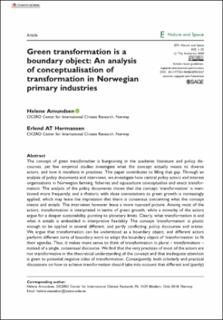| dc.description.abstract | The concept of green transformation is burgeoning in the academic literature and policy discourses, yet few empirical studies investigate what the concept actually means to diverse actors, and how it manifests in practices. This paper contributes to filling that gap. Through an analysis of policy documents and interviews, we investigate how central policy actors and interest organisations in Norwegian farming, fisheries and aquaculture conceptualise and enact transformation. The analysis of the policy documents shows that the concept ‘transformation’ is mentioned more frequently, and a rhetoric with close connotations to green growth is increasingly applied, which may leave the impression that there is consensus concerning what the concept means and entails. The interviews however leave a more nuanced picture. Among most of the actors, transformation is interpreted in terms of green growth, while a minority of the actors argue for a deeper sustainability, pointing to planetary limits. Clearly, what transformation is and what it entails is embedded in interpretive flexibility. The concept ‘transformation’ is plastic enough to be applied in several different, and partly conflicting, policy discourses and arenas. We argue that transformation can be understood as a boundary object, and different actors perform different sorts of boundary work to adapt the boundary object of ‘transformation’ to fit their agendas. Thus, it makes more sense to think of transformation in plural – transformations – instead of a single, consensual discourse. We find that the very practices of most of the actors are not transformative in the theoretical understanding of the concept and that inadequate attention is given to potential negative sides of transformation. Consequently, both scholarly and practical discussions on how to achieve transformation should take into account that different and (partly) conflicting interpretations will continue to exist and contribute to distinguish between different degrees of sustainability and related pathways. | en_US |

